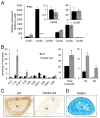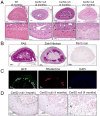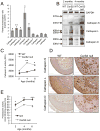Development of pheochromocytoma in ceramide synthase 2 null mice
- PMID: 26113602
- PMCID: PMC5586043
- DOI: 10.1530/ERC-15-0058
Development of pheochromocytoma in ceramide synthase 2 null mice
Abstract
Pheochromocytoma (PCC) and paraganglioma are rare neuroendocrine tumors of the adrenal medulla and sympathetic and parasympathetic paraganglia, for which mutations in ∼15 disease-associated genes have been identified. We now document the role of an additional gene in mice, the ceramide synthase 2 (CerS2) gene. CerS2, one of six mammalian CerS, synthesizes ceramides with very-long (C22-C24) chains. The CerS2 null mouse has been well characterized and displays lesions in several organs including the liver, lung and the brain. We now demonstrate that changes in the sphingolipid acyl chain profile of the adrenal gland lead to the generation of adrenal medullary tumors. Histological analyses revealed that about half of the CerS2 null mice developed PCC by ∼13 months, and the rest showed signs of medullary hyperplasia. Norepinephrine and normetanephrine levels in the urine were elevated at 7 months of age consistent with the morphological abnormalities found at later ages. Accumulation of ceroid in the X-zone was observed as early as 2 months of age and as a consequence, older mice displayed elevated levels of lysosomal cathepsins, reduced proteasome activity and reduced activity of mitochondrial complex IV by 6 months of age. Together, these findings implicate an additional pathway that can lead to PCC formation, which involves alterations in the sphingolipid acyl chain length. Analysis of the role of sphingolipids in PCC may lead to further understanding of the mechanism by which PCC develops, and might implicate the sphingolipid pathway as a possible novel therapeutic target for this rare tumor.
Keywords: acyl chain length; ceramide; ceroid; lipofuscin; oxidative stress; pheochromocytoma; sphingolipid.
© 2015 Society for Endocrinology.
Conflict of interest statement
The authors declare no conflict of interest.
Figures







Similar articles
-
Ablation of ceramide synthase 2 causes chronic oxidative stress due to disruption of the mitochondrial respiratory chain.J Biol Chem. 2013 Feb 15;288(7):4947-56. doi: 10.1074/jbc.M112.402719. Epub 2013 Jan 2. J Biol Chem. 2013. PMID: 23283968 Free PMC article.
-
Ectopic expression of ceramide synthase 2 in neurons suppresses neurodegeneration induced by ceramide synthase 1 deficiency.Proc Natl Acad Sci U S A. 2016 May 24;113(21):5928-33. doi: 10.1073/pnas.1522071113. Epub 2016 May 9. Proc Natl Acad Sci U S A. 2016. PMID: 27162368 Free PMC article.
-
Ablation of ceramide synthase 2 exacerbates dextran sodium sulphate-induced colitis in mice due to increased intestinal permeability.J Cell Mol Med. 2017 Dec;21(12):3565-3578. doi: 10.1111/jcmm.13267. Epub 2017 Jul 12. J Cell Mol Med. 2017. PMID: 28699686 Free PMC article.
-
Genetics of pheochromocytomas and paragangliomas.Best Pract Res Clin Endocrinol Metab. 2010 Dec;24(6):943-56. doi: 10.1016/j.beem.2010.05.001. Best Pract Res Clin Endocrinol Metab. 2010. PMID: 21115163 Review.
-
Genetics of adrenal tumors.Minerva Endocrinol. 2009 Jun;34(2):107-21. Minerva Endocrinol. 2009. PMID: 19471236 Review.
Cited by
-
Developmental role of PHD2 in the pathogenesis of pseudohypoxic pheochromocytoma.Endocr Relat Cancer. 2021 Oct 18;28(12):757-772. doi: 10.1530/ERC-21-0211. Endocr Relat Cancer. 2021. PMID: 34658364 Free PMC article.
-
Sphingolipid metabolism in cancer signalling and therapy.Nat Rev Cancer. 2018 Jan;18(1):33-50. doi: 10.1038/nrc.2017.96. Epub 2017 Nov 17. Nat Rev Cancer. 2018. PMID: 29147025 Free PMC article. Review.
-
LASS5 Interacts with SDHB and Synergistically Represses p53 and p21 Activity.Curr Mol Med. 2016;16(6):582-90. doi: 10.2174/1566524016666160607090012. Curr Mol Med. 2016. PMID: 27280497 Free PMC article.
-
Clinical and pathological significance of Homo sapiens ceramide synthase 2 (CerS-2) in diverse human cancers.Biosci Rep. 2019 May 7;39(5):BSR20181743. doi: 10.1042/BSR20181743. Print 2019 May 31. Biosci Rep. 2019. PMID: 30988071 Free PMC article. Review.
-
Deep sphingolipidomic and metabolomic analyses of ceramide synthase 2 null mice reveal complex pathway-specific effects.J Lipid Res. 2025 Jul;66(7):100832. doi: 10.1016/j.jlr.2025.100832. Epub 2025 May 29. J Lipid Res. 2025. PMID: 40449731 Free PMC article.
References
-
- Ben-David O, Pewzner-Jung Y, Brenner O, Laviad EL, Kogot-Levin A, Weissberg I, Biton IE, Pienik R, Wang E, Kelly S, et al. Encephalopathy caused by ablation of very long acyl chain ceramide synthesis may be largely due to reduced galactosylceramide levels. Journal of Biological Chemistry. 2011;286:30022–30033. doi: 10.1074/jbc.M111.261206. - DOI - PMC - PubMed
-
- Chen A, Zorrilla E, Smith S, Rousso D, Levy C, Vaughan J, Donaldson C, Roberts A, Lee K-F, Vale W. Urocortin 2-deficient mice exhibit gender-specific alterations in circadian hypothalamus-pituitary-adrenal axis and depressive-like behavior. The Journal of Neuroscience. 2006;26:5500–5510. doi: 10.1523/JNEUROSCI.3955-05.2006. - DOI - PMC - PubMed
Publication types
MeSH terms
Substances
Grants and funding
LinkOut - more resources
Full Text Sources
Medical

